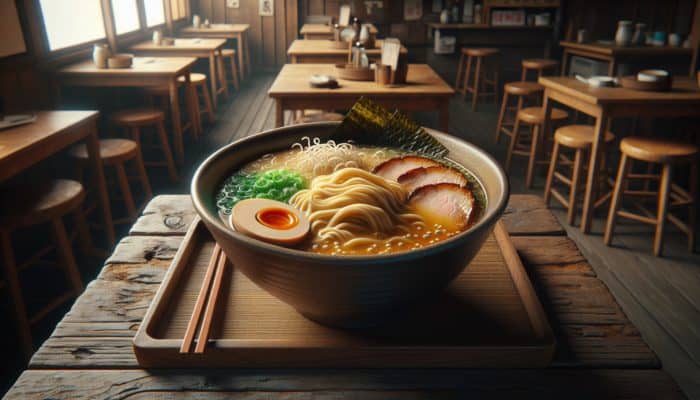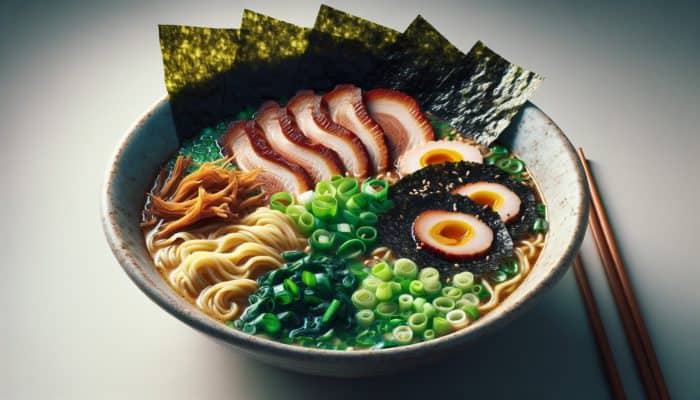Unlock the Secrets to Homemade Japanese Ramen Mastery
Discover the Allure of Ramen: A Global Favorite

Ramen stands as a beloved noodle soup originating from Japan, enchanting food lovers globally with its rich flavors and comforting essence. This iconic dish is characterized by a robust broth, elastic noodles, and a medley of toppings that harmoniously blend textures and tastes. From the lively ramen shops in Tokyo to kitchens around the world, ramen transcends cultural boundaries, evolving to suit local palates while maintaining its authentic roots. The versatility of ramen is its greatest charm, inspiring chefs and home cooks alike to experiment with diverse styles and ingredients, resulting in culinary creations that range from simple to intricate.
Over the years, ramen has evolved from humble beginnings, leading to a plethora of regional variations and sparking creativity in the culinary world. Its warming qualities and adaptability have transformed it into a staple in numerous households. Whether savored on a cold evening or enjoyed as a quick lunch, ramen continues to resonate deeply with people, providing warmth and satisfaction in every delightful bowl.
Key Ingredients to Crafting Authentic Ramen
The essence of a remarkable bowl of ramen lies in its fundamental ingredients. These components, which include noodles, broth, tare, and toppings, each play a crucial role in shaping the overall flavor profile and texture of the dish. Opting for high-quality ingredients is essential, as they can significantly enhance your ramen experience. Authentic ramen noodles, typically crafted from wheat flour, water, and kansui (an alkaline mineral water), are foundational to the dish. They deliver a firm and chewy texture that complements the broth beautifully.
Often referred to as the soul of ramen, the broth comes in various styles, each with its own unique characteristics. Popular varieties include tonkotsu (made from pork bones), shoyu (soy sauce-based), miso, and shio (salt-based) broths. Each type requires specific ingredients and cooking methods to develop its distinct flavor profile. Tare, the seasoning added to the broth, is vital for enhancing depth and complexity. Meanwhile, toppings such as chashu pork, menma (bamboo shoots), and nori (seaweed) bring additional layers of flavor and visual appeal, culminating in a delicious and satisfying dish.
Begin your ramen-making adventure with straightforward yet flavorful recipes that incorporate these essential ingredients. As you build confidence, feel free to explore various broths and toppings to customize your culinary experience.
- Basic Tonkotsu Ramen
- Shoyu Ramen with Chicken Broth
- Vegetarian Miso Ramen
- Spicy Shio Ramen
- Seafood Ramen
- Cold Ramen Salad
- Instant Ramen Hacks
- Noodle-less Ramen Bowls
Kickstart Your Ramen-Making Journey at Home
Embarking on your ramen-making journey at home offers endless opportunities for customization, whether you prefer a straightforward or more elaborate approach. Start with accessible recipes designed to help you master the foundational techniques necessary for crafting delicious ramen. A basic tonkotsu or shoyu ramen recipe is an excellent introduction, teaching you essential methods while yielding satisfying results.
Invest time in grasping the intricacies of each component — the broth, tare, noodles, and toppings — and how they work together to create the perfect bowl. Initiate your process with a richly flavored broth, allowing it to simmer gently to extract maximum flavor. As your skills improve, concentrate on perfecting your noodles, adjusting cooking times to achieve your preferred texture. Finally, unleash your creativity with toppings, incorporating seasonal ingredients or personal favorites to elevate your ramen experience.
As you delve deeper into this culinary adventure, document your experiments and take note of what works well and what could be improved. This reflective practice not only hones your skills but ensures that each bowl of ramen you create becomes a testament to your evolving taste.
Expert Insights for Creating Exceptional Japanese Ramen at Home

How to Perfect Your Ramen Broths?
Mastering ramen broths is a vital skill that requires an understanding of different styles, each offering unique flavor profiles and preparation techniques. The three most popular varieties are tonkotsu, shoyu, and miso, each necessitating specific methods to achieve their signature richness and complexity. For example, tonkotsu broth is made by boiling pork bones for several hours, allowing collagen and fat to create a creamy texture, while shoyu broth is lighter and relies on soy sauce for a savory depth.
To successfully create your broth recipes, prioritize high-quality ingredients and allow ample simmering time. The secret to a rich broth lies in the cooking process: for tonkotsu, aim for a minimum of 12 hours of cooking to fully extract flavor; for shoyu, blending chicken or seafood stock can beautifully complement the soy sauce base. Real-world examples of successful ramen broth recipes often involve a degree of trial and error, showcasing each cook’s individual flair and taste preferences.
Experiment with various aromatics like garlic, ginger, and onion to enhance your broth. Balancing the ingredients is crucial — too much fat can overwhelm the flavor, while too little may leave it lacking. Continuously taste to refine the components, ensuring a personalized touch. Ultimately, your broth should reflect your culinary personality, crafted with intention and passion.
What Are the Keys to Achieving Perfect Ramen Noodles?
The significance of perfect ramen noodles cannot be overstated; they are essential for delivering an authentic ramen experience. Ideally, noodles should be chewy and firm, serving as the perfect vessel for the broth. Different styles of ramen often require specific noodle types, which can vary in thickness and texture. For instance, tonkotsu ramen pairs excellently with thicker, wavy noodles that hold onto the rich broth, while shoyu ramen may use thinner, straighter noodles.
Cooking technique is paramount. Always strive for an al dente finish, as the noodles will continue to soften once mixed with hot broth. Timing is crucial; adhere closely to package instructions while tasting frequently to ensure they reach the perfect texture. A quick rinse in cold water post-cooking can halt the cooking process, preserving that ideal firmness.
When serving, remember to add the noodles to the bowl just before pouring the broth over them. This ensures they remain hot and maintain their texture. Additionally, consider experimenting with homemade noodles for a uniquely personalized touch; while it requires more effort, the results can elevate your ramen to extraordinary heights.
How to Elevate Ramen with Toppings?

Toppings are the finishing touch that enhances your ramen experience, contributing not only flavor but also texture and visual appeal. Common toppings include chashu pork, menma, green onions, and nori; however, the beauty of ramen lies in its flexibility. Each topping adds unique characteristics, enriching the overall dining experience. For instance, the rich, fatty notes of chashu beautifully complement the broth, while crispy nori introduces an appealing textural contrast.
To further enhance your ramen, focus on the preparation of each topping. Chashu can be braised for hours for optimal tenderness, while menma can be marinated for an extra burst of flavor. Soft-boiled eggs, marinated in soy sauce, provide creaminess and richness, while fresh herbs add a refreshing touch. Thoughtfully arranging toppings can elevate the dish’s visual appeal; artfully layering them creates an inviting feast that beckons indulgence.
Some actionable steps for preparing and presenting your toppings include marinating eggs overnight for maximum flavor, slicing chashu thinly for an elegant presentation, and strategically placing green onions for a pop of color. Don’t hesitate to explore unconventional ingredients or combinations that resonate with your personal taste.
How to Achieve the Ideal Ramen Balance?
Achieving the perfect balance in ramen involves a careful interplay between the broth, noodles, and toppings. Each element must harmonize with the others to create a memorable dish. Start by tasting your broth and adjusting its intensity, ensuring it has the right levels of saltiness, sweetness, and umami. Tare, the seasoning added to the broth, is critical in this balance; adjust it according to your taste while encouraging experimentation.
When selecting your noodles, consider their texture and thickness. If your broth is rich and fatty, opt for thicker noodles that can bear the weight of the broth. Conversely, a lighter broth like shio may pair better with thinner noodles. The ratio of noodles to broth is also significant; aim for a balanced bowl where neither element overwhelms the other.
Finally, toppings can greatly impact your overall experience. If your broth is particularly rich, adding lighter toppings like fresh herbs or bean sprouts can provide a delightful contrast. Regularly adjust elements as you cook and taste; the goal is to create a bowl of ramen that offers a symphony of flavors and textures, enticing you to savor every last drop.
Selecting the Right Ramen Style to Match Your Taste Preferences
Explore the Various Types of Ramen Available
Ramen presents a wide variety of styles, each showcasing distinct flavors and ingredients tailored to diverse taste preferences. The most recognized types include tonkotsu, shoyu, miso, and shio. Tonkotsu, or pork bone ramen, is celebrated for its creamy, rich broth that, despite being labor-intensive to prepare, rewards with unparalleled depth and complexity. Shoyu ramen, characterized by its soy sauce base, offers a lighter yet savory experience, typically featuring chicken or vegetable broth. Miso ramen introduces a hearty, fermented flavor profile, often accompanied by a mix of vegetables and proteins, while shio ramen delivers a more delicate, salt-forward taste.
Each ramen style is built upon specific regional traditions and preferences, reflecting local ingredients and cultural influences. For instance, Hokkaido is famous for its miso ramen, while the Kumamoto region boasts various interpretations of tonkotsu. This diversity invites personal exploration; you can choose a style that resonates with your palate or experiment with combinations to create something uniquely yours.
Understanding these styles enables you to make informed choices about which type of ramen to prepare based on your preferences. Reflect on the depth of flavor you enjoy and the dining experience you wish to create, selecting a style that aligns with your culinary desires.
Aligning Ramen with Your Unique Taste Preferences
Selecting the right ramen style to match your taste preferences requires thoughtful reflection on flavor profiles. If you enjoy robust, rich flavors, tonkotsu may be your ideal choice, providing a creamy mouthfeel accompanied by deep pork essence. For those who prefer lighter broths, shio or shoyu could be more suitable, offering a satisfying yet less heavy experience.
Consider your favorite flavors when choosing your ramen style. If you appreciate umami-rich experiences, miso ramen, with its fermented depth, is worth exploring. Additionally, think about whether you enjoy your ramen spicy or mild; many ramen recipes can be easily adjusted with the addition of chili oil or pepper to cater to your heat tolerance.
Don’t overlook dietary needs, as they can significantly influence your ramen selection. For individuals mindful of animal products, vegetarian ramen options are abundant, with vegetable broth serving as a fantastic base. Ultimately, your ramen experience should reflect your unique taste preferences, allowing you to indulge in a bowl that excites your palate.
Customizing Ramen for Dietary Needs
One of the delightful features of ramen is its adaptability, making it easy to customize for various dietary restrictions. Whether you’re vegetarian, vegan, or gluten-free, numerous ways exist to create a fulfilling ramen experience. For vegetarians and vegans, begin with a vegetable broth, which can be enriched with umami through ingredients like mushrooms, seaweed, or miso paste. This ensures a flavorful base that meets dietary restrictions.
For noodles, gluten-free alternatives are readily available, crafted from rice or other gluten-free grains. These noodles often cook similarly to traditional ramen noodles, providing a comparable texture and experience. Furthermore, consider incorporating a variety of vegetables as toppings; they not only add nutritional benefits but also enhance the dish’s visual appeal.
Customizing your ramen allows you to explore unique flavor profiles, such as incorporating Asian-inspired sauces or marinades. For those eager to experiment, trying different broths and toppings can lead to delightful discoveries; the key is to remain open-minded and playful in your culinary endeavors. Ultimately, the goal is to relish a bowl of ramen that aligns with your dietary needs while delivering a comforting and satisfying experience.
Essential Techniques for Perfecting Ramen Preparation
Cooking Noodles to Achieve the Ideal Texture
Mastering the technique of achieving the perfect texture for your ramen noodles is vital for crafting a delicious bowl. Begin by selecting the right noodles; fresh ramen noodles offer superior texture and flavor compared to their dried counterparts. When cooking, adhere closely to package instructions, keeping in mind that timing can vary based on the noodle type and thickness. The objective is to achieve an al dente finish, where the noodles possess a firm bite that complements the broth.
To cook noodles perfectly, bring a pot of water to a rolling boil before adding the noodles. Stir gently to prevent sticking, and taste frequently to monitor texture. Once cooked, remove the noodles from the pot and rinse them under cold water immediately. This step halts the cooking process, ensuring they maintain their ideal firmness when combined with the hot broth. Additionally, rinsing helps eliminate excess starch, which can lead to a gummy texture.
Consider experimenting with different cooking methods to discover your preferred techniques, such as using a wok or steamer for a unique presentation. The preparation of your noodles is just as crucial as the broth; well-cooked noodles can elevate the entire ramen experience, creating delightful harmony with the other components.
Mastering Flavor Balance in Your Ramen
Mastering the art of flavor balance is essential for crafting a harmonious ramen dish. Every component — the broth, noodles, tare, and toppings — should complement one another, contributing to a cohesive and satisfying experience. Start by focusing on your broth. Taste it regularly as it simmers, fine-tuning levels of saltiness, sweetness, and umami to reach the desired depth. Remember that the tare added to the broth can significantly influence flavor; adjusting its composition can enhance or mellow the overall profile.
The noodles also play a vital role in balancing flavors. Consider their texture and how they interact with the broth. For rich and creamy broths, thicker noodles can provide a delightful contrast, while lighter broths may pair better with thinner noodles. Furthermore, the toppings you select can either enhance or disrupt the flavor balance; for instance, earthy mushrooms or vibrant vegetables can elevate the overall experience by introducing additional layers of complexity.
As you cook, take notes on what adjustments yield the best results. This iterative process not only sharpens your skills but also enables you to create a recipe that is distinctly yours. Balancing flavors is an ongoing journey, and your palate will evolve as you experiment with various ingredients and techniques.
Serving and Presenting Ramen with Flair
Presentation significantly enhances the ramen experience; a well-served bowl invites indulgence and excitement. When serving ramen, opt for deep bowls that help retain heat, ensuring the broth remains warm and inviting. Start by placing the cooked noodles at the bottom of the bowl, followed by a generous ladle of your steaming broth to envelop them. This layering technique increases flavor absorption and enhances texture.
Artfully arrange your toppings atop the noodles, considering both visual appeal and flavor combinations. For example, fan out slices of chashu, add a perfectly halved soft-boiled egg, and sprinkle with green onions for a burst of color. Fresh herbs, nori, and sesame seeds can also be incorporated for added flair. Presentation goes beyond aesthetics; it significantly impacts the overall dining experience, making each bowl of ramen feel special and worthy of enjoyment.
Finally, consider serving your ramen alongside side dishes, such as pickled vegetables or a light salad, to enrich the meal. This thoughtful approach elevates the dining experience and encourages appreciation for the culinary art you have created. Remember, the journey of ramen-making is as enjoyable as the final dish; savor each moment as you craft your perfect bowl.
Research-Backed Benefits of Crafting the Best Japanese Ramen Recipes at Home
Exploring the Nutritional Benefits of Ramen
When prepared thoughtfully, ramen can serve as a nutritious meal. The nutritional profile largely depends on the quality of ingredients involved. A well-crafted broth, for example, can be rich in vitamins and minerals, particularly when made from wholesome components like bones, vegetables, and seaweed. Toppings such as leafy greens, proteins, and various vegetables further enhance the nutritional value, providing essential nutrients and enriching the overall dish.
Consider integrating nutrient-dense ingredients into your ramen. For instance, adding spinach or bok choy not only boosts the meal’s vitamin content but also offers a refreshing contrast to the rich broth. Lean proteins, such as chicken or tofu, contribute significantly to the dish’s overall protein profile, making it both satisfying and nourishing. The key lies in striking a balance between indulgence and health-conscious choices, ultimately crafting a ramen dish that nourishes the body while tantalizing the taste buds.
As you explore various ramen recipes, experiment with ingredient substitutions that align with your dietary goals. The versatility of ramen permits endless variations, making it possible to cater to diverse dietary needs without sacrificing flavor. This adaptability is just one reason why ramen remains a beloved dish around the globe.
The Comforting Psychological Benefits of Enjoying Ramen
The process of preparing and enjoying ramen can yield significant psychological benefits. Ramen often evokes feelings of warmth and comfort, triggering nostalgia and satisfaction for many. The act of crafting a bowl of ramen can be a meditative experience, allowing individuals to engage fully in the cooking process, which may lead to improved mood and overall well-being.
Sharing a bowl of ramen with friends or family fosters a sense of community, enhancing connections and social bonds. Coming together around a steaming bowl of homemade ramen can invoke feelings of happiness and togetherness, contributing to overall life satisfaction. Furthermore, the sensory experience of enjoying ramen — from the alluring aroma of the broth to the satisfying slurp of the noodles — can evoke positive emotions and enrich one’s culinary journey.
As you immerse yourself in the world of ramen, embrace the psychological comfort it offers. Allow yourself to indulge in the creative process of cooking and relish the joy that comes from sharing a delicious meal with loved ones. This connection through food can transform an ordinary meal into a cherished memory.
The Cultural Significance of Ramen in Culinary Traditions
Ramen occupies a notable position in global culinary culture, symbolizing comfort and community. Its origins in Japan reflect a rich history, evolving from a simple street food into a highly regarded dish enjoyed around the world. The versatility of ramen enables it to adapt to local ingredients and preferences, resulting in various regional styles that honor its roots while embracing global influences.
This adaptability has established ramen as a canvas for culinary creativity, where chefs and home cooks alike can explore diverse flavor combinations and techniques. Ramen serves as a cultural bridge, connecting individuals through shared experiences and culinary exploration. Whether relished in a bustling ramen shop or lovingly crafted at home, ramen transcends geographical boundaries, inviting everyone to partake in its comforting embrace.
Ramen also embodies the spirit of innovation within culinary traditions, with fusion variations emerging that blend traditional Japanese methods with global flavors. This evolution reflects the dish’s enduring relevance and cultural significance, making it a cherished choice for food enthusiasts worldwide.
The Simplicity of Ramen Preparation
The beauty of ramen lies in its accessibility; recipes can often be straightforward and quick to prepare at home. For busy cooks, this ease of preparation makes ramen an ideal meal option. With a well-stocked pantry and some fundamental techniques, anyone can whip up a satisfying bowl in under an hour.
Starting with pre-made or instant noodles can significantly reduce cooking time, allowing you to focus on creating a delicious broth and selecting toppings. Many ramen recipes offer flexibility, enabling cooks to adjust ingredients based on what they have available, making it a versatile choice for any day of the week. Even when preparing a homemade broth, utilizing pressure cookers can drastically shorten cooking time while still delivering depth of flavor.
As you explore the art of ramen-making, embrace the simplicity of the dish while appreciating the depth it can offer. The accessibility of ramen recipes allows for experimentation and creativity, making it a go-to meal for both novice cooks and seasoned chefs alike. The joy of creating a delicious bowl of ramen at home is within reach for everyone, and the rewards are boundless.
The Endless Variety of Ramen Recipes to Explore
The diversity of ramen recipes stands as one of its most exciting aspects, enabling endless experimentation with flavors and ingredients. This variety caters to different dietary preferences and culinary creativity, empowering cooks to explore and innovate. With countless recipes available, you can uncover new combinations and techniques that elevate your ramen experience.
Ramen’s flexibility allows you to tailor recipes based on the season, incorporating fresh, local produce to craft unique flavor profiles. For example, spring might inspire the addition of vibrant herbs and greens, while autumn could prompt the use of earthy mushrooms and root vegetables. By leveraging seasonal ingredients, you not only enhance the taste and nutritional value of your ramen but also celebrate the bounty of each season.
Moreover, the fusion of ramen with other culinary traditions opens up exciting opportunities for creativity. Merging traditional ramen elements with flavors from diverse cuisines can result in unique and memorable dishes that push the boundaries of this beloved meal. The possibilities are truly endless, ensuring that ramen enthusiasts can find inspiration in every bowl they create.
Innovative Ramen Recipes and Culinary Creations to Explore
Exploring Fusion Ramen Dishes
Fusion ramen represents an exciting frontier for culinary exploration, merging traditional elements with flavors from other cultures to create unique and thrilling dishes. This innovative approach invites creativity, enabling cooks to experiment with unexpected ingredients and techniques. For example, incorporating Mexican flavors like chipotle or salsa verde can yield a spicy and tangy twist on classic ramen.
Another popular fusion idea involves utilizing Italian ingredients, such as integrating pesto or even cheese as a topping. These combinations can surprise and delight, providing a fresh take on the classic dish while still honoring the fundamental elements of ramen. The fusion concept encourages culinary innovation, making it a fantastic opportunity to let your imagination run wild.
As you begin your fusion ramen journey, consider starting with a base recipe and gradually incorporating new ingredients or techniques. Document your experiments and refine your approach based on feedback from family and friends. This iterative process not only enhances your skills but also leads to the creation of unique dishes that reflect your culinary identity.
Innovating with Ramen: Creative Approaches
Innovation in ramen can take numerous forms, whether it involves experimenting with new broths, noodles, or toppings. One innovative approach is to explore different broths beyond the traditional styles, such as developing a coconut milk-based broth for a creamy, tropical twist. This opens up new flavor profiles that can surprise and excite your palate.
Additionally, consider incorporating seasonal ingredients that reflect the bounty of each season, such as fresh peas in spring or pumpkin in autumn. Using unexpected toppings, such as fermented vegetables or unique oils, can also elevate the overall experience while adding depth and complexity to the dish.
Culinary techniques can also provide avenues for innovation. For instance, consider smoking your proteins or toppings to introduce a smoky flavor, or employing sous-vide methods to achieve perfectly cooked ingredients. The key to innovation lies in curiosity and a willingness to experiment. Allow yourself to take risks in the kitchen, and don’t shy away from breaking traditional boundaries in pursuit of creating something extraordinary.
Seasonal Ramen Variations for Culinary Exploration
Utilizing seasonal ingredients is a fantastic way to enhance your ramen while bringing fresh flavors and textures to your bowls. Each season offers a unique array of ingredients that can be incorporated to create dishes that resonate with the time of year. For example, in spring, consider using tender asparagus and peas, which can be lightly sautéed and added to your ramen for a burst of freshness.
During summer, incorporate vibrant herbs like basil or mint, along with grilled vegetables, to create a lighter, more refreshing bowl. Autumn invites the opportunity to explore earthy flavors; adding roasted root vegetables, mushrooms, and squash can create a hearty, comforting dish that embodies the season’s bounty. Winter, on the other hand, beckons richness; consider using hearty greens, slow-cooked proteins, and warming spices to keep you cozy.
Embracing seasonal ingredients not only enhances the flavor and nutritional content of your ramen but also connects you with the rhythm of nature. By adapting to the changing seasons, you can elevate your ramen dishes while celebrating the diverse array of ingredients available. This practice not only makes cooking more exciting but also ensures that your ramen remains fresh and relevant throughout the year.
Frequently Asked Questions About Ramen Preparation
What is the best ramen type for beginners?
The best ramen type for beginners is shoyu ramen. It has a balanced flavor profile and is relatively simple to prepare, making it an excellent starting point for newcomers to ramen-making.
Can I use instant noodles for homemade ramen?
Yes, instant noodles can be used for homemade ramen. They simplify the cooking process, allowing you to focus on creating a delicious broth and selecting toppings.
How do I store leftover ramen?
To store leftover ramen, separate the noodles from the broth and toppings, placing each in airtight containers. This prevents the noodles from becoming soggy and allows you to enjoy them later.
What are some popular ramen toppings?
Popular ramen toppings include chashu pork, soft-boiled eggs, menma (bamboo shoots), green onions, nori (seaweed), and various vegetables.
How can I make ramen vegetarian?
To prepare vegetarian ramen, utilize vegetable broth as the base and include plant-based toppings like tofu, mushrooms, and a variety of vegetables to enhance flavor and texture.
Can I freeze homemade ramen broth?
Yes, homemade ramen broth can be frozen. Ensure you cool it completely before transferring it to freezer-safe containers. It can be stored for several months.
What is tare in ramen?
Tare is a concentrated seasoning added to ramen broth to enhance its flavor. It can be composed of various ingredients, including soy sauce, miso, or salt, depending on the ramen style.
How can I modify the spiciness of my ramen?
To adjust the spiciness of your ramen, add chili oil, fresh chili peppers, or spicy miso to the broth. Start with small amounts and gradually increase to reach your desired level of heat.
What is the ideal noodle texture for ramen?
The ideal noodle texture for ramen is chewy and firm, often referred to as al dente. This texture allows the noodles to withstand the broth and toppings without becoming mushy.
Is homemade ramen healthier than store-bought?
Homemade ramen can be healthier than store-bought options, as you have complete control over the ingredients used, allowing you to select high-quality and nutritious components for your broth and toppings.
Stay updated with our latest news on our Facebook page!
The post Best Japanese Ramen Recipes For Home: A Universal Guide appeared first on https://cookinggods.com
The Article Japanese Ramen Recipes: Your Ultimate Home Cooking Guide Was Found On https://limitsofstrategy.com

